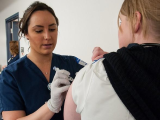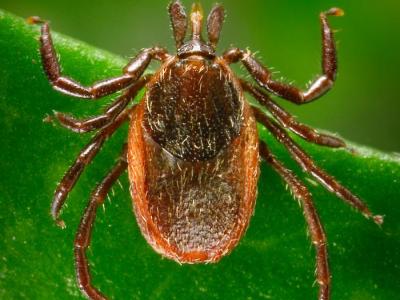Jan 7, 2005 (CIDRAP News) – The new recommendation to vaccinate children between 6 and 23 months old could have been lost in the hubbub of the influenza vaccine shortage this season. Yet authorities are terming this year's vaccination rates a success story.
The Centers for Disease Control and Prevention in Atlanta (CDC) reported that 36.6% of children younger than 2 had received flu shots, according to Morbidity and Mortality Weekly Report for Dec 17, 2004. The data came from the Behavioral Risk Factor Surveillance System (BRFSS) survey, a monthly, state-based, random telephone survey of civilian adults in the United States.
The use of some other vaccines for preschool children was lower in the first year. Hepatitis B had an 8% rate its first year, varicella had 16%, and pneumococcal conjugate vaccine (PCV) saw about 40% vaccination coverage among those eligible, according to CDC data.
Three major factors could have influenced the flu vaccination rate, experts suggested: ongoing education for providers about the need to vaccinate, a good supply of vaccine for the age-group, and an unusual number of flu-related deaths among children last season.
Healthcare practitioners have long been concerned about the increased rates of respiratory disease in children, but it has been hard to separate influenza from other causes, explained Carolyn Bridges, MD, medical epidemiologist with the CDC's National Immunization Program, who works with the Advisory Committee on Immunization Practices (ACIP). Recent research has made it clear that even healthy children younger than 2 years old appear at greatest risk for influenza complications, she said.
The annual flu-related hospitalization rate for children younger than 2 is 1 to 2 per 1,000, she said. The same rate for healthy adults is about 1 in 5,000.
ACIP had previously "encouraged" vaccinating 6- to-23-month-olds, but changed its advice to a formal recommendation in April 2004, Bridges said.
The lengthy process for moving from "encouragement" to recommendation allows time to educate providers about the changing goals. It also gives providers time to order the needed flu vaccine, Bridges said.
Changing guidelines for the flu is a "major logistical undertaking" because of the long lead time required to order vaccine and the relatively compressed period for effectively administering it, Bridges said.
One factor worked in favor of those trying to vaccinate the youngest and most vulnerable: the supplier. Pediatricians and others had to place their orders early with Aventis Pasteur, the sole supplier of vaccine for 6- to 23-month-olds, Bridges said. They could be grateful that Chiron wasn't licensed to produce vaccine for kids younger than 4. When Chiron's vaccine supply was pulled because of contamination, not a drop of vaccine for this age-group was lost.
In addition, the flu-related deaths of children in more than 40 states last year helped highlight the seriousness of the ACIP recommendation, Bridges said.
Two years ago, when ACIP was only encouraging vaccination, the immunization rate was 7%, Bridges said. The jump to 36.6% represents "a lot of progress," she added.
Yet the recommendation has been overshadowed by the vaccine shortage, Bridges acknowledged. "Who knows how much better it might have been had we not had the vaccine supply issues?"
States that are grappling with those issues report considerable variation from the national data on flu shots for toddlers, although most state officials say their sample sizes are far smaller than the nationwide survey.
In California, about 25% of kids in the 6- to 23-month age-group were immunized this year, said Robert Schechter, MD, medical officer with the immunization branch of the California Department of Health Services. That figure is higher among Kaiser Permanente enrollees, but it's not public data, he added.
"There's room for optimism that the uptake, while far from 100%, has been quite high for something that has been recently recommended," Schechter said.
California still has about 500,000 doses available overall, including preservative-free vaccine available through both the Vaccines for Children program and private providers. The state has delivered between 6 million and 7 million doses of vaccine this season, with the bulk of them going to the estimated 10 million people at highest risk, Schechter said.
In Colorado, 22.4% of 6- to 23-month-olds got flu vaccine, said Ned Calonge, MD, MPH, chief medical officer for the Colorado Department of Public Health and Environment. Last year only 7.4% of eligible infants were immunized. The flu-related deaths of a dozen children in Colorado last might have encouraged parents to obtain the shots for their children, he noted.
The mercury-containing preservative thimerosal has remained controversial because of lingering worries that it is associated with autism, a connection that numerous studies have not shown. The state officials reported that some people are concerned about access to preservative-free vaccine, which remained available in California, Colorado, and Minnesota this week. But officials from all three states said the thimerosal issue didn't make a big impression this year.
"We were really prepared for that issue," said Kristen Ehresmann, RN, MPH, manager of the immunization, tuberculosis, and international health section of the Minnesota Department of Health. "We had fact sheets and things. But with the reduction of the supply, that became a secondary issue."
See also:




















